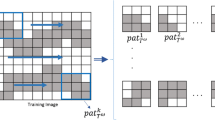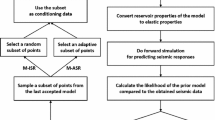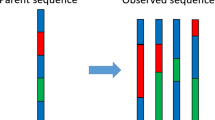Abstract
Bayesian modeling requires the specification of prior and likelihood models. In reservoir characterization, it is common practice to estimate the prior from a training image. This paper considers a multi-grid approach for the construction of prior models for binary variables. On each grid level we adopt a Markov random field (MRF) conditioned on values in previous levels. Parameter estimation in MRFs is complicated by a computationally intractable normalizing constant. To cope with this problem, we generate a partially ordered Markov model (POMM) approximation to the MRF and use this in the model fitting procedure. Approximate unconditional simulation from the fitted model can easily be done by again adopting the POMM approximation to the fitted MRF. Approximate conditional simulation, for a given and easy to compute likelihood function, can also be performed either by the Metropolis–Hastings algorithm based on an approximation to the fitted MRF or by constructing a new POMM approximation to this approximate conditional distribution. The proposed methods are illustrated using three frequently used binary training images.











Similar content being viewed by others
References
Bartolucci F, Besag J (2002) A recursive algorithm for Markov random fields. Biometrika 89:724–730
Besag J (1974) Spatial interaction and the statistical analysis of lattice systems. J R Stat Soc B 36:192–225
Chatterjee S, Dimitrakopoulos R, Mustapha H (2012) Dimensional reduction of pattern-based simulation using wavelet analysis. Math Geosci 44:343–374
Clifford P (1990) Markov random fields in statistics. In: Grimmett GR, Welsh DJA (eds) Disorder in physical systems. Oxford University Press, London, pp 19–31
Cressie NAC (1993) Statistics for spatial data, 2nd edn. Wiley, New York
Cressie N, Davidson J (1998) Image analysis with partially ordered Markov models. Comput Stat Data Anal 29:1–26
Descombes X, Mangin J, Pechersky E, Sigelle M (1995) Fine structures preserving model for image processing. In: Proc. 9th SCIA 95, Uppsala, Sweden, pp 349–356
Eidsvik J, Avseth P, Omre H, Mukerji T, Mavko G (2004) Stochastic reservoir characterization using prestack seismic data. Geophysics 69:978–993
Friel N, Rue H (2007) Recursive computing and simulation-free inference for general factorizable models. Biometrika 94:661–672
Friel N, Pettitt AN, Reeves R, Wit E (2009) Bayesian inference in hidden Markov random fields for binary data defined on large lattices. J Comput Graph Stat 18:243–261
Geman S, Geman D (1984) Stochastic relaxation, Gibbs distributions, and the Bayesian restoration of images. IEEE Trans Pattern Anal Mach Intell 6:721–741
Geyer CJ, Thompson EA (1995) Annealing Markov chain Monte Carlo with applications to ancestral inference. J Am Stat Assoc 90:909–920
Gonzalez EF, Mukerji T, Mavko G (2008) Seismic inversion combining rock physics and multiple-point geostatistics. Geophysics 73:R11–R21
Hurn M, Husby O, Rue H (2003) A tutorial on image analysis. In: Møller J (ed) Spatial statistics and computational methods. Lecture notes in statistics, vol 173. Springer, New York, pp 87–139
Journel J, Zhang T (2006) The necessity of a multiple-point prior model. Math Geol 38:591–610
Kindermann R, Snell JL (1980) Markov random fields and their applications. Am Math Soc, Providence
Künsch HR (2001) State space and hidden Markov models. In: Barndorff-Nielsen OE, Cox DR, Klüppelberg C (eds) Complex stochastic systems. Chapman & Hall/CRC, London
Li SZ (2009) Markov random field modeling in image analysis, 3rd edn. Springer, London
Pettitt AN, Friel N, Reeves R (2003) Efficient calculation of the normalising constant of the autologistic and related models on the cylinder and lattice. J R Stat Soc B 65:235–247
Scott AL (2002) Bayesian methods for hidden Markov models: recursive computing in the 21st century. J Am Stat Assoc 97:337–351
Stien M, Kolbjørnsen O (2011) Facies modeling using a Markov mesh model specification. Math Geosci 43:611–624
Strebelle S (2002) Conditional simulation of complex geological structures using multiple-point statistics. Math Geol 34:1–21
Tjelmeland H (1996) Stochastic models in reservoir characterization and Markov random fields for compact objects. PhD thesis, Norwegian University of Science and Technology. Thesis number 44:1996
Tjelmeland H, Austad H (2012) Exact and approximate recursive calculations for binary Markov random fields defined on graphs. J Comput Graph Stat 21:758–780
Tjelmeland H, Besag J (1998) Markov random fields with higher order interactions. Scand J Stat 25:415–433
Ulvmoen M, Omre H (2010) Improved resolution in Bayesian lithology/fluid inversion from prestack seismic data and well observations: Part 1—methodology. Geophysics 75:R21–R35
Winkler G (2003) Image analysis, random fields and Markov chain Monte Carlo methods. Springer, London
Zhang T, Pedersen SI, Knudby C, McCormick D (2012) Memory-efficient categorical multi-point statistics algorithms based on compact search trees. Math Geosci 44:863–879
Acknowledgements
We thank the sponsors of the Uncertainty in Reservoir Evaluation (URE) project at the Norwegian University of Science and Technology (NTNU). We also thank two anonymous journal reviewers for comments to an earlier version of this paper.
Author information
Authors and Affiliations
Corresponding author
Appendix: Additional Plots
Appendix: Additional Plots
In this Appendix, the results of the simulation from \(p_{\theta}^{\star}(x)\) and from the conditional distribution \(\tilde{p}_{\theta}(x|z)\) are presented, when z is the observations of 11 vertical traces in the training image. In Fig. 12, we show realizations from the fitted \(p_{\theta}^{\star}(x)\), and in Fig. 13 we show Box and Whisker plots of the corresponding standardized descriptive statistics. In Fig. 14, we show realizations from the POMM approximation of the fitted \(\tilde{p}_{\theta}(x|z)\), when z is 11 vertical traces taken from the training image, and corresponding marginal probabilities are shown in Fig. 15. Box and Whisker plots of the corresponding standardized descriptive statistics are shown in Fig. 16.
Rights and permissions
About this article
Cite this article
Toftaker, H., Tjelmeland, H. Construction of Binary Multi-grid Markov Random Field Prior Models from Training Images. Math Geosci 45, 383–409 (2013). https://doi.org/10.1007/s11004-013-9456-3
Received:
Accepted:
Published:
Issue Date:
DOI: https://doi.org/10.1007/s11004-013-9456-3










